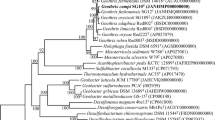Abstract
All the enzymes required for the oxidation of acetate to CO2 via the citric acid cycle were found in Desulfobacter postgatei. To obtain in vivo evidence for the operation of this cycle, the sulfate reducing bacterium was grown on [14C]acetate in the presence of a large pool of 12CO2 and the incorporation of 14C into glutamate (≙ 2-oxoglutarate), aspartate (≙ oxaloacetate), and alanine (≙ pyruvate) was studied. The labelling data were found to be consistent with (i) the oxidation of acetate to CO2 via the reactions of the citric acid cycle, (ii) the synthesis of citrate via a citrate (si)-synthase, and (iii) the anaplerotic synthesis of oxaloacetate from acetate and 2 CO2 via pyruvate as intermediate.
Similar content being viewed by others
References
Badziong W, Ditter B, Thauer RK (1979) Acetate and carbon dioxide assimilation by Desulfovibrio vulgaris (Marburg), growing on hydrogen and sulfate as sole energy source. Arch Microbiol 123:301–305
Brandis-Heep A, Gebhardt NA, Thauer RK (1983) Anaerobic acetate oxidation to CO2 by Desulfobacter postgatei. 1. Demonstration of all enzymes required for the operation of the citric acid cycle. Arch Microbiol 136:222–229
Bryant MP, Tzeng SF, Robinson IM, Joyner AE Jr (1971) Nutrient requirements of methanogenic bacteria. In: Pohland FG (ed) Anaerobic biological treatment processes, Advances in Chemistry Series 105. American Chemical Society, Washington DC, pp 23–40
Decker K, Thauer RK, Jungermann K (1966) Die Kohlenhydratsynthese in Clostridium kluyveri. I. Isotopenversuche zur Biosynthese der Ribose. Biochem Z 345:461–471
Dorn M, Andreesen JR, Gottschalk G (1978) Fumarate reductase of Clostridium formicoaceticum. Arch Microbiol 119:7–11
Fuchs G, Stupperich E, Thauer RK (1978) Acetate assimilation and the synthesis of alanine, aspartate and glutamate in Methanobacterium thermoautotrophicum. Arch Microbiol 117:61–66
Fuchs G, Stupperich E, Eden G (1980) Autotrophic CO2 fixation in Chlorobium limicola. Evidence for the operation of a reductive tricarboxylic acid cycle in growing cells. Arch Microbiol 128:64–71
Kornberg HL (1966) Anaplerotic sequences and their role in metabolism. In: Campbell PN, Greville GD (eds) Essays in biochemistry, vol 2. Academic Press, London New York, pp 1–31
Roberts RB, Abelson PH, Cowie DB, Bolton ET, Britton RJ (1957) Studies of biosynthesis in Escherichia coli. Carnegie Institute, Washington
Simon H, Floss HG (1967) Bestimmung der Isotopenverteilung in markierten Verbindungen. Springer, Berlin Heidelberg New York, p 53–64
Sorokin YI (1966) Investigation of the structural metabolism of sulfate-reducing bacteria with C14. Mikrobiologiya 35:967–977
Spector LB (1972) Citrate cleavage and related enzymes. In: Boyer PD (ed) The enzymes, vol VII. Academic Press, New York London, pp 357–389
Tomlinson N, Barker HA (1954) Carbon dioxide and acetate utilization by Clostridium kluyveri. I. Influence of nutritional conditions on utilization patterns. J Biol Chem 209:585–595
Widdel F (1980) Anaerober Abbau von Fettsäuren und Benzoesäure durch neu isolierte Arten Sulfat-reduzierender Bakterien. Doctoral Thesis, Univ Göttingen
Widdel F, Pfennig N (1981) Studies on dissimilatory sulfate-reducing bacteria that decompose fatty acids. I. Isolation of new sulfatereducing bacteria enriched with acetate from saline environments. Description of Desulfobacter postgatei gen. nov. sp. nov. Arch Microbiol 129:395–400
Author information
Authors and Affiliations
Rights and permissions
About this article
Cite this article
Gebhardt, N.A., Linder, D. & Thauer, R.K. Anaerobic acetate oxidation to CO2 by Desulfobacter postgatei . Arch. Microbiol. 136, 230–233 (1983). https://doi.org/10.1007/BF00409850
Received:
Accepted:
Issue Date:
DOI: https://doi.org/10.1007/BF00409850




